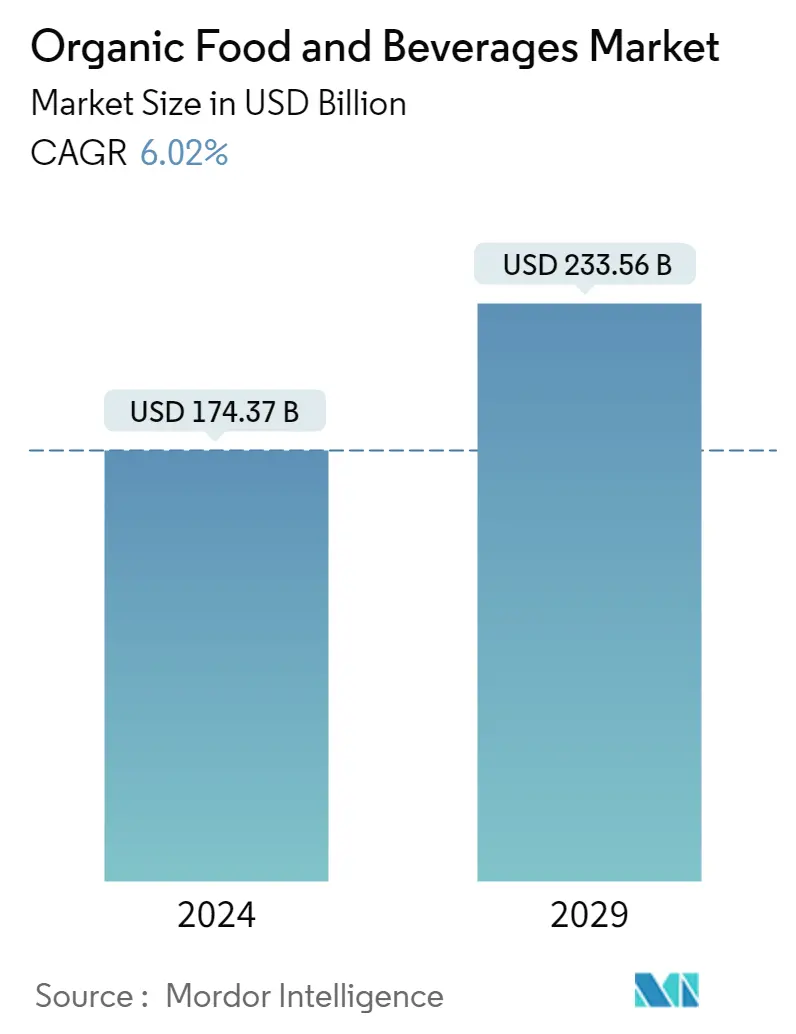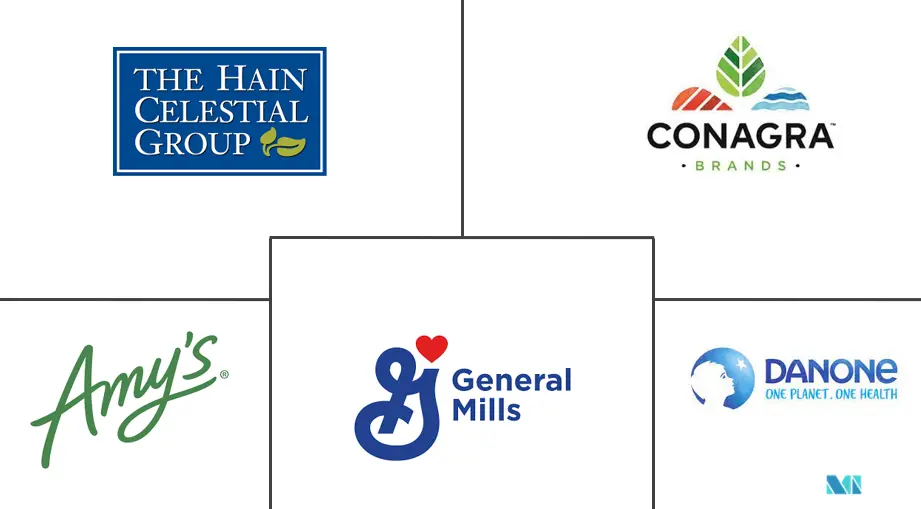Market Size of Organic Food and Beverages Industry

| Study Period | 2019 - 2029 |
| Market Size (2024) | USD 174.37 Billion |
| Market Size (2029) | USD 233.56 Billion |
| CAGR (2024 - 2029) | 6.02 % |
| Fastest Growing Market | Asia Pacific |
| Largest Market | North America |
| Market Concentration | Low |
Major Players
*Disclaimer: Major Players sorted in no particular order |
Organic Food and Beverages Market Analysis
The Organic Food and Beverages Market size is estimated at USD 174.37 billion in 2024, and is expected to reach USD 233.56 billion by 2029, growing at a CAGR of 6.02% during the forecast period (2024-2029).
The primary factor driving the expansion of the global organic food and beverages market is consumers' quicker adoption of healthy and natural foods and beverages. Increasing consumer awareness about the health and benefits of organic food products has further stimulated market growth. People are choosing organic food and drink more frequently. To meet the rising consumer demand, various manufacturers are creating labeled organic foods and drinks, such as juice with natural fruit ingredients and no added sugar. Moreover, with the growing number of chronic diseases such as cardiac issues, cancer, diabetes, and the rise in healthcare costs, consumers are increasingly focusing on their diet. This is one of the primary reasons driving the organic food and beverages market.
Moreover, the government's involvement in the organic food and beverages market, where the government has taken various initiatives to differentiate between false and actual labeling, has attracted consumers to the organic foods and beverages market. Also, the market growth can be attributed to the consumer's belief that organic food products are safer, more nutritious, and better in taste than conventional food items. Thus, the factor drives the per capita spending in this specific market.
The COVID-19 pandemic has significantly affected the organic food and beverages market. Due to this uncertainty, consumers' purchase patterns have changed as the consumers become aware of the necessity of a robust immune system; therefore, consumers have preferred more organic and natural foods. For example, General Mills Inc., one of the major players in this specific industry, has witnessed a growth of 8% in net sales per its annual company report. Thus, the pandemic had a positive effect on this market.
Organic Food and Beverages Industry Segmentation
A food product that is grown, prepared, and processed without the use of any chemicals is referred to as organic food and beverages. Additionally, producing organic food and drink prohibits using chemical pesticides, fertilizers, and preservatives. The global organic food and beverages market is segmented by product type, distribution channel, and geography. The market is segmented into organic foods and beverages based on product type. Organic food is further segmented into organic fruit & vegetables, organic meat, fish & poultry, organic dairy products, frozen & processed foods, and others.
Similarly, organic beverages are further segmented into fruit and vegetable juices, dairy, coffee, tea, and others. Based on the distribution channel, the market is segmented into supermarkets/hypermarkets, convenience stores, specialty stores, and online stores. The market is segmented based on geography: North America, Europe, Asia-Pacific, South America, and Middle East & Africa. For each segment, the market sizing and forecasts have been done based on value (in USD million).
| By Product Type | |||||||
| |||||||
|
| By Distribution Channel | |
| Supermarkets/Hypermarkets | |
| Convenience Stores | |
| Specialty Stores | |
| Online Stores | |
| Other Distribution Channels |
| Geography | |||||||||
| |||||||||
| |||||||||
| |||||||||
| |||||||||
|
Organic Food and Beverages Market Size Summary
The organic food and beverages market is experiencing significant growth, driven by an increasing consumer shift towards healthier and natural food options. This trend is fueled by heightened awareness of the health benefits associated with organic products, prompting consumers to choose these over conventional alternatives. The market is further bolstered by government initiatives aimed at ensuring the authenticity of organic labeling, which has enhanced consumer trust. The COVID-19 pandemic has also positively impacted the market, as consumers have become more health-conscious, seeking products that support a robust immune system. This has led to a surge in demand for clean-label food and beverages, with consumers keen on understanding the ingredients and sourcing of their food. The preference for organic products is particularly strong in regions like France, where health benefits are a primary motivator for consumption.
The Asia Pacific region is emerging as the fastest-growing market for organic food and beverages, with India and China leading in production due to their large populations and increasing consumer awareness. Government support in these countries, such as India's Traditional Agriculture Development Scheme, is facilitating the growth of organic farming. The market is highly competitive, with major players like General Mills, Danone, and The Hain Celestial Group actively acquiring smaller companies and innovating products to meet evolving consumer preferences. Recent acquisitions, such as Danone's purchase of Happy Family, highlight the strategic focus on expanding organic product offerings. The market's growth is also reflected in the rising sales of organic products, driven by consumer demand for preservative-free and naturally produced foods.
Organic Food and Beverages Market Size - Table of Contents
-
1. MARKET DYNAMICS
-
1.1 Market Drivers
-
1.2 Market Restraints
-
1.3 Porter's Five Forces Analysis
-
1.3.1 Threat of New Entrants
-
1.3.2 Bargaining Power of Buyers/Consumers
-
1.3.3 Bargaining Power of Suppliers
-
1.3.4 Threat of Substitute Products
-
1.3.5 Intensity of Competitive Rivalry
-
-
-
2. MARKET SEGMENTATION
-
2.1 By Product Type
-
2.1.1 Organic Foods
-
2.1.1.1 Organic Fruit & Vegetables
-
2.1.1.2 Organic Meat, Fish & Poultry
-
2.1.1.3 Organic Dairy Products
-
2.1.1.4 Organic Frozen & Processed Foods
-
2.1.1.5 Other Organic Foods
-
-
2.1.2 Organic Beverages
-
2.1.2.1 Fruit and Vegetable Juices
-
2.1.2.2 Dairy
-
2.1.2.3 Coffee
-
2.1.2.4 Tea
-
2.1.2.5 Other Organic Beverages
-
-
-
2.2 By Distribution Channel
-
2.2.1 Supermarkets/Hypermarkets
-
2.2.2 Convenience Stores
-
2.2.3 Specialty Stores
-
2.2.4 Online Stores
-
2.2.5 Other Distribution Channels
-
-
2.3 Geography
-
2.3.1 North America
-
2.3.1.1 United States
-
2.3.1.2 Canada
-
2.3.1.3 Mexico
-
2.3.1.4 Rest of North America
-
-
2.3.2 Europe
-
2.3.2.1 United Kingdom
-
2.3.2.2 Germany
-
2.3.2.3 France
-
2.3.2.4 Russia
-
2.3.2.5 Italy
-
2.3.2.6 Spain
-
2.3.2.7 Rest of Europe
-
-
2.3.3 Asia-Pacific
-
2.3.3.1 India
-
2.3.3.2 China
-
2.3.3.3 Japan
-
2.3.3.4 Australia
-
2.3.3.5 Rest of Asia-Pacific
-
-
2.3.4 South America
-
2.3.4.1 Brazil
-
2.3.4.2 Argentina
-
2.3.4.3 Rest of South America
-
-
2.3.5 Middle-East and Africa
-
2.3.5.1 South Africa
-
2.3.5.2 Saudi Arabia
-
2.3.5.3 Rest of Middle-East and Africa
-
-
-
Organic Food and Beverages Market Size FAQs
How big is the Organic Food and Beverages Market?
The Organic Food and Beverages Market size is expected to reach USD 174.37 billion in 2024 and grow at a CAGR of 6.02% to reach USD 233.56 billion by 2029.
What is the current Organic Food and Beverages Market size?
In 2024, the Organic Food and Beverages Market size is expected to reach USD 174.37 billion.

